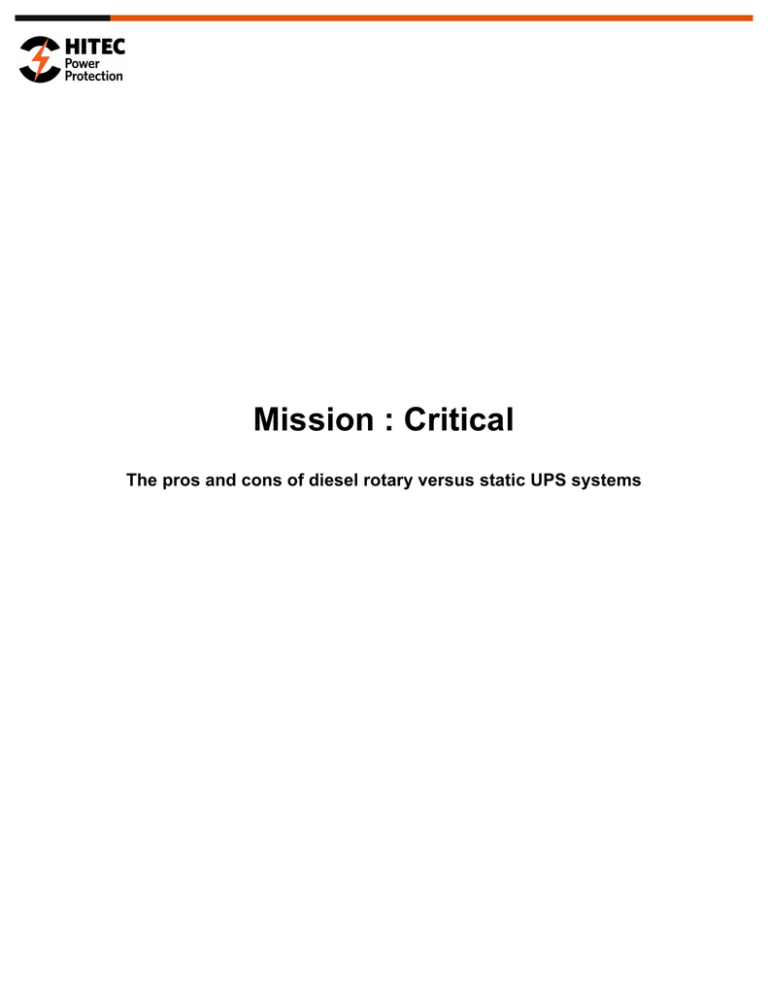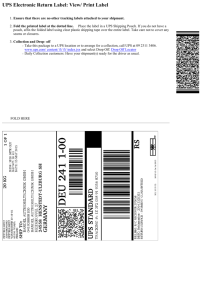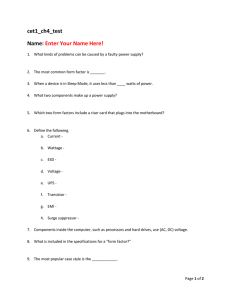
Mission : Critical
The pros and cons of diesel rotary versus static UPS systems
The pros and cons of diesel rotary versus static systems
Introduction
Mission critical facilities are broadly defined as containing any operation that, if interrupted, will
cause a negative impact on business activities, ranging from losing revenue to jeopardizing
legal conformity to, in extreme cases, loss of life. Data centers, call centers, hospitals,
manufacturing processes, and military installations are the more common types of buildings that
could be considered mission critical.
The role of an uninterruptible power supply (UPS) in these applications is clear; there must be a
temporary power bridge to support the load between the loss of utility and the transfer to diesel
generator. Second, the computerized equipment such as server, storage, and network devices
that run these processes are sensitive to fluctuations in power quality; these fluctuations are
mitigated with the use of a UPS system. These UPS systems can be divided into two broad
categories based on their method of energy storage. Static UPS systems use batteries much
like those found in an automobile to the energy required for the ride-through period. Dynamic
UPS systems use a flywheel to store kinetic energy for the same task.
Currently, cost efficiency remains one of the biggest challenges for mission-critical companies.
In today’s data-driven world, few companies can afford to be without reliable information
technology (IT) infrastructure, making power efficiency and reliability a critical priority in most
organizations and the selection of the best UPS power source a top business objective.
UPS systems offer emergency power when the primary utility input fails—ensuring critical loads
remain online. In contrast to an emergency power system or standby generators, UPS delivers
clean, constant, and instantaneous protection from all costly power interruptions.
Static UPS Systems
Mission-critical building owners can choose from a variety of UPS systems. Currently, statics
UPS systems are the most popular option: mostly due to a wide variety of available capacities
and a relatively low cost per kVA of the equipment itself. Static systems, available from a range
of 10 kVA to 1,000 kVA, are popular among engineers for their availability to provide costeffective protection for loads less than 1mW. While most companies select static UPS as the
most popular choice, it is not always the best choice.
Due to popularity, most companies assume all UPS equipment is static-based, with batteries
providing energy during short power outages. Companies do not realize the myriad of
complications static battery-based UPS systems introduce—or the high price tag. In addition to
the initial costly investment, operators have to meet the high cost of maintaining and operating
battery-based systems.
Static battery-based systems require a larger footprint. Consider that a five-minute battery
runtime for a 400-kilowatt system translates to nearly 200 square-foot of space. Additionally,
consider that space has tight environmental requirements to maintain a narrow range of
temperatures for the batteries. Then, consider the short lifespan of static battery UPS systems,
with batteries typically lasting as little as three and an average of five years. The short lifespan
translates to multiple removals, replacements, and maintenance cycles—all of which generate
additional costs.
©2016 Hitec Power Protection. All rights reserved. This publication or parts of this publication may not be used, reproduced, photocopied, transmitted, or
stored in any system, without the prior written permission of Hitec Power Protection, the copyright owner.
Page 2 of 5
The pros and cons of diesel rotary versus static systems
A traditional battery UPS system is composed of a rectifier, batteries, and inverter. The system
provides temporary power via its batteries that transfer the critical load to a standby power
generator that supplements power for longer outages. A static UPS system produces levels of
distortion upon the output voltage distortions are the most common causes of equipment
malfunctions or power overload in static systems.
Batteries provide an advantage in cost and availability – replacement batteries are readily
available when they fail or are at end of life. Battery monitoring systems are also commonly
implemented to report on the health of the battery cells, and provide predictive information about
the system.
Diesel UPS Systems
Next-generation diesel rotary-based systems (DRUPS) offer a new portfolio of power options.
These systems are less costly, more environmentally suitable, and offer a longer lifespan.
By contrast, DRUPS could mean the difference between efficiency and squandered resources
because the energy efficiency of a typical DRUPS unit is two percent more efficient at full load
than a static UPS system. Moreover, at partial loads, where most UPS equipment operates, the
difference in efficiency is greater.
While a few percentage points may not seem like much, given the 24-hour nature of missioncritical applications, the difference can result in literally millions of dollars in savings over the
lifecycle of the gear.
Furthermore, a DRUPS system integrates the traditional backup components into a single
system that works with kinetic energy, not batteries. When utility power is lost, the system
retrieves energy from its flywheel to support the critical load until the diesel engine takes over.
The lifecycle of a DRUPS system is nearly 30 years, and requires component replacement half
as often as static or about every ten years. In addition, a DRUPS system is more reliable
because it produces clean voltage, and can support even leading power factor loads.
DRUPS systems are not without their own drawbacks. First, the rotating portions of the system
have to be maintained on a regular basis, and bearings lubricated several times a year.
Second, spare parts are more difficult to transport and store due to their size and weight. Third,
a DRUPS system requires more training to operate and are less common that their Static
counterparts.
The Green UPS System
Diesel rotary-based UPS systems are “greener” than static UPS systems since they do not use
standby batteries for energy storage. In other words, a DRUPS system does not require the use
of components that incorporate significant quantities of environmentally damaging chemicals
such as lead acid, nickel, or cadmium. A myriad of reasons exist why a DRUPS system is
greener than traditional UPS options.
©2016 Hitec Power Protection. All rights reserved. This publication or parts of this publication may not be used, reproduced, photocopied, transmitted, or
stored in any system, without the prior written permission of Hitec Power Protection, the copyright owner.
Page 3 of 5
The pros and cons of diesel rotary versus static systems
A considerable difference exists between the energy efficiency of static UPS and diesel rotarybased UPS systems. Static UPS systems include a high number of components that produce
energy losses. Static UPS vendors oftentimes leave out an important fact: the energy necessary
to recharge batteries and for cooling of the standby batteries and power electronics. The static
UPS concept is based on power conversion in the power path, meaning losses occur when
converting alternating current to direct current and DC back to AC. Some rotary UPS concepts
exist that use power conversion (static rotary) and power electronics (hybrid).
Alternatively, a DRUPS system is the only rotary concept supplying conditioned AC power
directly to the load without power conversion or use of power electronics. Diesel rotary-based
UPS systems combine a diesel engine, an alternator, and a kinetic energy storage element
(flywheel) to provide conditioned and continuous power to the IT load. No power conversion
translates into a two to three percent improved efficiency. Eliminating the recharging and cooling
of batteries adds another two to three percent.
Diesel rotary-based UPS systems can achieve efficiency levels of up to 97 percent, while the
overall efficiency level of the best static UPS equipment, using advanced IGBT inverters, will
reach around 94 percent, resulting in a system efficiency of 92 percent taking all additional
energy losses of other components into account.
Operating Efficiency
Static UPS vendors convey a different message to organizations considering uninterrupted
power infrastructure. When purchasing any type of UPS system, it is imperative to ensure when
reviewing the efficiency of the system that organizations include the energy use of all the
necessary components within the numbers provided by the vendors.
When compared to a static UPS system, the diesel rotary-based UPS system replaces all
battery-backed static UPS equipment required to support critical IT loads, and the standby
diesel generating equipment required for continuous power supply. By combining these two
functions within a single, simple, compact concept, a DRUPS system provides tangible and
measurable environmental benefits. With loads greater than 400 kW, the DRUPS technology
will beat any other UPS technology on efficiency. For loads less than 400 kW, a Static system is
going to be the most cost-effective solution.
For example, is the air conditioning required for both the inverters and battery room included?
The lack of ancillary equipment required for a static UPS system can reduce its overall
efficiency by around two to three percent.
DRUPS vs. Other UPS Systems
From a CAPEX and OPEX perspective, the longer financial view supports the use of dynamic
over static systems due to the longevity of the equipment and the lower operating costs that
come from the system. Mission-critical organizations that take into account the total cost of
ownership of these systems quickly realize why rotary is the preferred UPS technology in most
areas of the world. Other UPS systems solve day-one capital issues, but create other financial
problems further into their lifecycle.
©2016 Hitec Power Protection. All rights reserved. This publication or parts of this publication may not be used, reproduced, photocopied, transmitted, or
stored in any system, without the prior written permission of Hitec Power Protection, the copyright owner.
Page 4 of 5
The pros and cons of diesel rotary versus static systems
Last Look
It is imperative for organizations to remember that a four to six percent savings in energy
efficiency using diesel rotary-based UPS technology is best for the environment, but it also has
a significant positive effect on the operating cost of the mission critical facility.
In order to future-proof power infrastructure and plan for current and future uptime and
expansion, companies should strongly consider the potential costs of upgrading a poorly
designed infrastructure. In today’s data-driven environment, organizations expecting zero
downtime must know the facts and stats of DRUPS versus static solutions.
Remember, alternatives are available for companies consider when shopping around for UPS
technology—and although battery technology is more prevalent, it is not always the best overall
choice for the organization.
©2016 Hitec Power Protection. All rights reserved. This publication or parts of this publication may not be used, reproduced, photocopied, transmitted, or
stored in any system, without the prior written permission of Hitec Power Protection, the copyright owner.
Page 5 of 5



